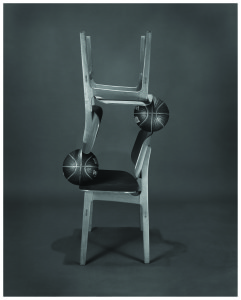Luis Gispert / 2003
Through the juxtaposition of the familiar and the unexpected, Luis Gispert reinvents the baroque drama, drawing from religious and pop cultural icons.
The second Baum Award was presented to Luis Gispert in 2003, with curatorial oversight by Heidi Zuckerman of the Berkeley Art Museum.
Gispert was born in New Jersey in 1972 to a family who had fled Cuba during the 1960s. Raised in Miami, Florida, his work is highly influenced by his early life, steeped in an era ruled by hip-hop and pop culture. Initially drawn to filmmaking, he received his Bachelor of Fine Art from the School of the Art Institute of Chicago before he pursued photography, earning a scholarship to the Master of Fine Arts program at Yale University.
Described as “at once baroque and surreal,” Gispert’s series, Urban Myth Pt. 1, earned him the 2003 Baum Award. The series features a signature juxtaposition of baroque composition and religious imagery with the social and material icons of pop culture, including cheerleaders, gaudy jewelry, and oversized boom boxes. In this body of work he weaves together notes of a patriarchal history with symbols of modern American culture composed in elaborately staged scenes.
Gispert’s work took a distinctive new direction with his 2011 series, Decepción, which showcased tricked-out cars, unsparingly upholstered in faux designer prints, through images surreally lit and photographed from inside the back seat looking out. He expertly paired each of these lavish interiors to a vast landscape seen stretching beyond the front windows. As a series, the work is an artistic documentation of a culture fueled by the reign of top fashion icons.
Themes of popular culture and its many icons have continued to appear in Gispert’s work taking form in sculpture and film (many incorporating a seemingly endless supply of classic boom boxes), as well as his distinctive photographic style. Known for work that is often colorful and bold, he turned to a more minimalistic approach in his series, All Oyster, No Pearl (2012). While still reflecting on the absurdity of pop culture he captures silhouettes of modern material icons portrayed in silver gelatin prints: bulky white headphones with two large silver hoop earrings dangling below each earphone; chairs balanced precariously using basketballs; a chair suspended by a single chain. While All Oyster, No Pearl is in some ways more subtle than his earlier work, he stays true to his roots by singling out the small things that reflect the material overabundance of American culture.
In a tangent from photography, Gispert’s 2015 series, Agua Regia, features a dozen compositions of gold chains cast expressively across fabricated backgrounds of black gravel. Many of the pieces are named after club music icons, launching the pure composition into the arena of cultural commentary.
Gispert’s work has exhibited internationally and is included in the collections of the Guggenheim Museum, New York; the Whitney Museum of American Art, New York; the San Francisco Museum of Modern Art; and the Miami Art Museum, among others. As of 2016, he lives and works in New York City and is represented by Stefan Lundgren Gallery in Spain.
Credits – 2003 Baum Award
| Host: | Berkeley Art Museum |
| Curator: | Heidi Zuckerman |
| Jury: | Cornelia Butler, Curator, Museum of Contemporary Art, Los Angeles |
| Heidi Zuckerman, Director and Chief Curator, Aspen Art Museum, former Phyllis Wattis MATRIX Curator at Berkeley Art Museum/Pacific Film Archive (BAM/PFA) | |
| Ralph Rugoff, Director of London’s Hayward Gallery, former Director of the Wattis Institute, California College of the Art and Craft |
vvlx,
hentai,
xporn,
xnxx,
sex việt,
Family Practice Doctors Near Me,
Ratify Treaties,
Best Hookup Apps,
Brunch On A Wednesday,
Comfortzone,
Plaza Premium Lounge Orlando Reviews,
Catering 77002,
Cauliflower And Coconut Curry,
Usa Rail Pass,
Active Duty Service Member,
Patch American Flag,
Farfetch Coupon Code,
Connect Google Mini,
Nike Mens High Top,
Bronny James Usc Basketball,
Anal Sex Prep,
Aesports,
Check Balance On Debit Card,
Add People Trustpilot,
Skype Ids,








